|
51. Maculinea alcon (Denis & Schiffermüller, 1775) / Alcon blue / Lycaenidae – Polyommatinae
NL: gentiaanblauwtje / D: Kleiner Moorbläuling, Lungenzian-Ameisen-Bläuling, Kreuzenzian-Ameisenbläuling / F: azuré de la croisette, azuré des moullières, le protée, l’argus blue marine
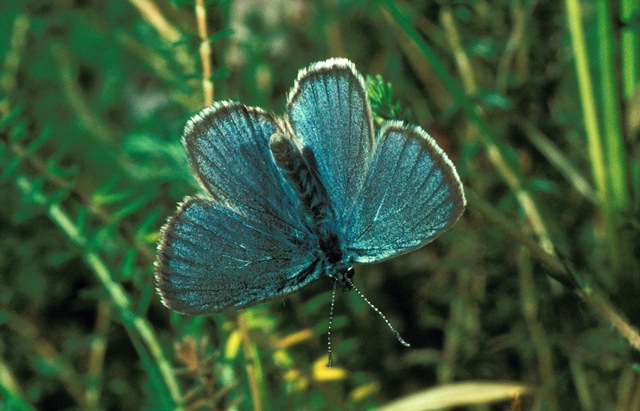 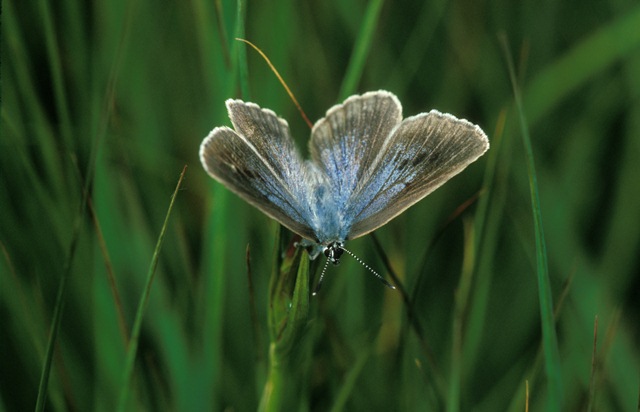 
Photographs: Frits Bink ©.
Small, wing length 17 (16-19) mm. The strongholds of this species in the Benelux are the Netherlands and Flanders where it occurs on wet places in heathland. Previously it was also known from wet unfertilized meadows and in the dunes near Wassenaar where Gentiana cruciata was the host-plant; in all other localities this is G. pneumonanthe.
In Wallonia it occurred up to 1973 in chalk grassland where G. cruciata was the host and these populations were named Maculinea rebeli (Hirsche 1904) but DNA-analyses proved that it belonged to the same species. However, in the Netherlands, a distinct race had occurred that was named Maculinea alcon arenaria (Lempke 1942), the adult butterflies of which were somewhat smaller, males pale blue and females black; on average their flight time was about two weeks earlier. This subspecies had occurred in the dunes on G. cruciata and in the wet meadow near Zegveld on G. pneumonanthe.
Butterflies are on the wing from end-June until end-August, peak early-August. Known from maritime and continental climates, amplitude 6 to 17, required heat sum 700°d, maximum tolerated 1500°d, corresponding climate windows 24 and 34 weeks.
The species has disappeared from many places, in the case of M. alcon arenaria because of changes in management of the nature reserves involved. The population on the wet meadow near Zegveld was extinguished around 1965 because the hay was cut too early in the season; that which occurred in the dunes disappeared about 1980 as a result of stopping the cattle grazing, which changed the nature of the vegetation succession, although the gentian still occurs but on other places in the neighbourhood.
Ecological characteristics
Behaviour over time
Overwintering: half grown L4 (final instar) larva in ant's nest.
Reproduction: oviposition starts after 1-2 days when the body contains 145 (108-163) eggs.
Larval feeding periods: feeding period in gentian fruit 14 (9-18) days, in autumn in ants nest about 4 weeks, after diapause, in spring 6-7 weeks.
Generations: always one.
Spreading of risk: spread in hatching of the pupae, partly depends on by the activity of the ants, a second overwintering may be possible.
Life cycle: egg 9 (7-11) days; larva about 47weeks; pupa about 22 days.
Life span of adult: very short, 1 week.
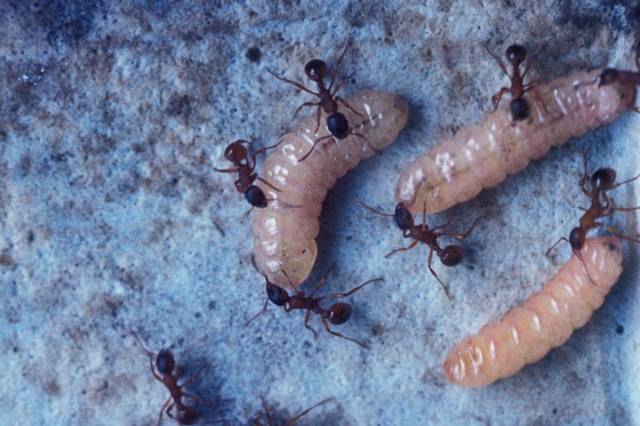 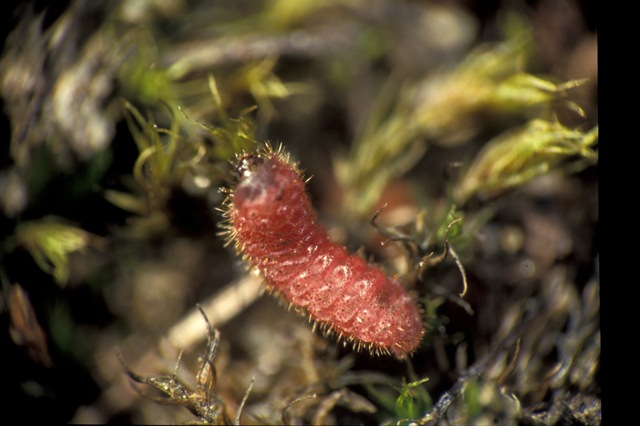
Photographs: Frits Bink ©.
Behaviour in space
From stay-at-home to migrant: stay-at-home, spatial requirement very modest. Migrating males observed following an edge like structure in the landscape.
Finding a mate: male patrols and looks for virgin females.
Orientation in the landscape: vague, on semi tall vegetation where gentians grow.
Oviposition: on the flower buds or corolla, usually 3 together.
Defence
Threats from other organisms: those ants which do not adopt the waiting larvae.
Myrmecophily: obligate, honey gland and pores functional, host ants Myrmica rubra, M. ruginodes, M. sabuleti, M. scabrinodis, M. schenki (Thomas et al. 1989).
Threats from the environment: survival of ants nest; risk of being destroyed by trampling, submerging or lack of food.
Feeding habits
Adult: nectar, however rarely feed on flowers, mostly seen on cross-leaved heather.
Larva: precarious period of adaptation of ants nest odour, larvae are carnivorous on small grubs but most of the time begging for food from the ants.
Observation on the distribution of ova and larvae on a single gentian at Leersum, Leersumse Veld, Netherlands, 14 August 1981 (see table 51-1): larvae hatched from the eggs through the bottom and that a larva from an egg laid on a leaf bored through the leaf to the upperside and looked for a flower bud and entered this by biting a hole in the corolla.
Table 51-1. Distribution of eggs and larvae over a single plant, 14-8-1981

Larval foodplants
Plant species: Gentianaceae, Gentiana cruciata, G. pneumonanthe.
Journal
Rearing experiments:
1. Based on specimens from national park Hoge Veluwe, Netherlands:
11 July 1983: female in copula collected.
14 July: within two days 106 eggs laid, remaining in body 57.
28 July: third instar larvae collected by opening the flowers and used for an introduction experiment at Meeuwenkampje. About 25 larvae were put into flowers of the marsh gentian at Meeuwenkampje, one per flower.
Monitoring of the introduction experiment at Meeuwenkampje.
30 July 1984: eggs present on flowers.
27 August 1985: more than 26 plants with eggs.
15 July 1986: egg laying butterfly, laid on the average three eggs per oviposition, most plants already with eggs.
The introduction implemented in this way appeared to be successful.
2. Based on specimens from Strabrecht, Netherlands:
19 July 1990: two females collected.
21 July: one female had laid 52 eggs.
28 July: eggs hatched.
29 July: all larvae had bored through the corolla to enter the flower.
31 July: larvae inside the flower were in L2, one larva died during moult.
2 August: larvae in L3.
4 August: larvae end L3, one larva had left the flower.
7 August: only one out of seven larvae inside the fruit, others in the corolla and eating the fruit.
9 August: all larvae moulted in the morning and left the flower in the evening, soon picked up by ants, Myrmica scrabinoides.
Table 51-2. Results of dissections

Table 51-3. Collection and observation localities
NL, Amerongen, Egelmeertje 52° 00’ 49”N – 5° 30’ 31”E; 17 August 1980 (egg shells present on gentians).
NL, Buurser Zand 52° 09’ 11”N – 6° 47’ 54”E; 4 July 2003.
NL, Hoge Veluwe 46 m, 52° 05’ 46”N – 5° 51’ 30”E; 11 July 1982.
NL, Hoge Veluwe 52° 05’N – 5° 51’E; 11 July 1983, 30 July 1984.
NL, Hoge Veluwe 52° 04’ 47”N – 5° 49’ 47”E; 27 July 2000.
NL, Leersum 52° 02’ 12”N – 5° 25’ 49”E; 14 August 1981, 15 August 1982, 15 July 1986.
NL, Meeuwenkampje 52° 02’ 57”N – 5° 32’ 53”E; (28 July 1983: larvae introduced), 30 July 1984 (eggs present), 27 August 1985, 15 July 1986.
NL, Schuitwater 51° 28’ 35”N – 6° 07’ 43”E; 8 July 2003.
NL, Strabrecht 51° 23’ 47”N – 5° 36’ 06”E; 19 July 1990.
M. alcon arenaria Lempke 1942 (now extinct).
NL, Wassenaar, Kijfhoek 52° 08’ 30”N – 4° 21’ 33”E; 21 June 1959 (19 July 1984 absent).
NL, Zegveld 52° 08’ 09”N – 4° 48’ 56”E; 28 June 1959, 4 July 1959 (c. 2000 butterflies seen).
Fig. 51-1. Maculinea alcon, phenogram adapted from Bos et al. 2006: 175.

Fig. 51-2. Maculinea alcon, habitat characteristics.

Fig. 51-3. Maculinea alcon, climate matrix, heat-sums 700 - 1500°d.
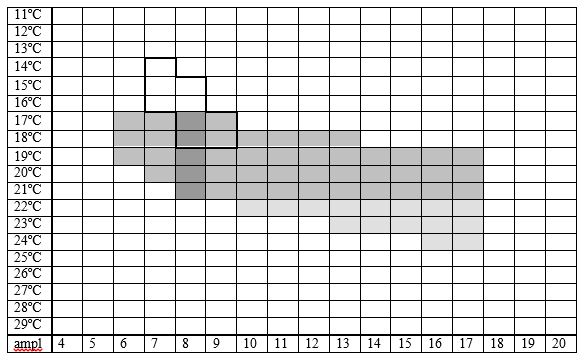
|











